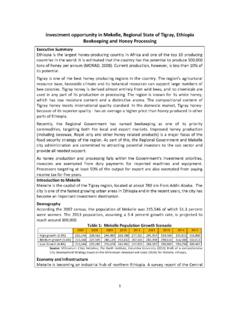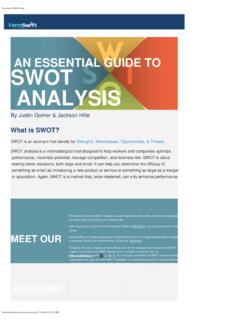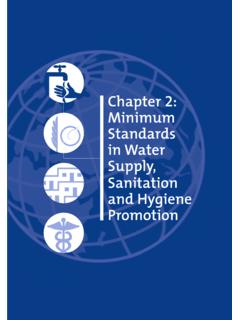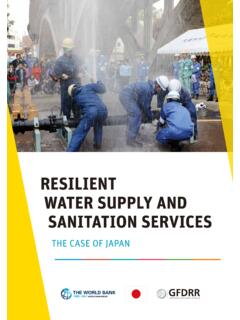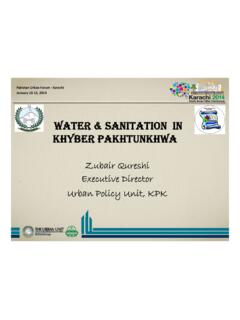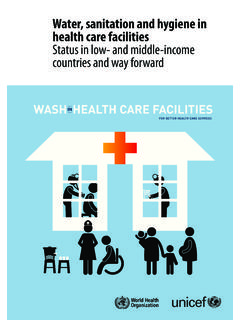Transcription of Water and Sanitation Needs Assessment Model USER GUIDE
1 MDG Needs Assessment Tools Water and Sanitation Needs Assessment Model user GUIDE DRAFT v. 24 July 2005 This user GUIDE is designed to be used in conjunction with the Water and Sanitation Needs Assessment Model available at This user GUIDE was prepared by Alice Wiemers Comments and suggestions are welcome and should be sent to the author at TABLE OF CONTENTS I. Needs Assessment MDG Needs II. Water AND Sanitation Model Basic Wastewater infrastructure is needed to support use of sewered Hygiene and Data III. USING THE Water AND Sanitation Modeling The Overview Population Water supply and Hygiene and Organizing Resource Summary Region Totals check--sums to access inputs above?
2 Yesyes IV. ADAPTING THE V. CHECKING RESULTS AND Checking Unrealistically high or low resource VI. OTHER RESOURCES AND FURTHER Needs Assessment and MDG-Based PRS I. Needs Assessment OVERVIEW This user GUIDE is a step-by-step introduction to the UN Millennium Project s Water and Sanitation Needs Assessment tool. It assumes that users have read the Handbook1 and have a basic familiarity with the fundamentals of an MDG Needs Assessment , but does not presume any prior technical knowledge of MDG Needs Assessment tools. The GUIDE should be used concurrently with the Water and Sanitation Needs Assessment tool, available at . In conjunction with the Handbook, it aims to help users embark on an MDG-based Water and Sanitation Needs Assessment .
3 Based on data input by the user , the Water and Sanitation Needs Assessment tool estimates the associated costs to support Water and Sanitation interventions as part of a strategy for meeting the MDGs at the national level. These estimates, along with estimates from other thematic areas (education, gender, rural and urban development, etc.) will help provide the basis for a national investment strategy for meeting the Millennium Development Goals. MDG Needs Assessments MDG Needs assessments are the analytical building blocks for developing MDG-based poverty reduction strategies. They aim at helping governments to answer the question, What investments will it take to meet the MDGs by 2015?
4 This approach marks a fundamental shift from current practice to strategy design, which asks the question: How can governments best allocate existing resources? Traditional sectoral work is thus based on forming annual budget allocations in a resource-constrained setting. An MDG Needs Assessment aims instead to help countries identify what resources are needed each year over a 10-year period to meet the MDGs by 2015. The resulting estimates can then be core inputs to an MDG investment strategy, including sequencing and capacity building, which, along with a policy and implementation outline, comprise a 10-year framework for meeting the MDGs. The Handbook specifies an approach to creating an MDG-based PRS, and describes in detail the steps required to conduct an MDG Needs Assessment .
5 This introduction will briefly outline these steps, and the role that the Water and Sanitation Model play in the overall MDG Needs Assessment process. First and foremost, the MDGs need to be interpreted at the country level. This entails defining quantitative outcome targets that are meaningful at the national level, and defining the areas of intervention that are needed to meet each of the MDGs. For Water and Sanitation , the MDG target aims to halve the proportion of people without sustainable access to safe drinking Water by 2015, but countries may wish to alter the target for example, by aiming to achieve it before 2015. Once outcome targets have been set, there are four steps in conducting a Needs Assessment , illustrated in Figure 1 and described below.
6 1 UN Millennium Project. Forthcoming 2005. Preparing MDG-Based Poverty Reduction Strategies: A Handbook of Best Practice. Figure 1: Steps in an MDG Needs Assessment 1 Develop list of interventions Users first need to define the critical interventions required to meet the MDGs. As outlined in the Handbook, interventions are defined broadly here as goods, services and infrastructure that need to be provided to generate outcomes. For Water and Sanitation , interventions include, for example, behavior change program. The UN Millennium Project recommends that thematic working groups be organized as part of the MDG-based planning process. These groups will help to GUIDE the selection of a comprehensive set of interventions that comprise each investment cluster [see Step 2 of the Handbook].
7 In many cases countries will have already elaborated such interventions in their national and sectoral planning documents. These documents should be a starting place for defining MDG interventions. The UN Millennium Project has drawn up sample lists of interventions to reach the MDGs that can also be an input into thematic working group discussions. This list will then have to be modified and adapted to national Needs . The Water and Sanitation interventions from these lists are the basis of the interventions outlined in this Model . 2 Specify targets for each set of interventions Once national outcome targets have been set and interventions have been identified, countries need to determine who the interventions should reach, what proportion of this population will need to be covered by 2015, and how many units of each intervention are needed to reach them.
8 This requires setting targets for each intervention and input quantity ratios that relate interventions to the people they reach. Where relevant, targets and their corresponding interventions can be disaggregated by age and gender as well as by urban and rural areas. For example, urban and rural areas often require distinct interventions and technologies or face very different unit Disaggregation by gender and age will help countries better target services to populations in need and to adjust their service delivery to a changing demographic profile. You will find advice on using the models to reflect additional disaggregation in Part Four of this GUIDE : Adapting the Model . 2 A clear distinction between urban and rural Needs is particularly warranted for the following categories: Water supply and Sanitation , transport infrastructure and energy services.
9 3 - Estimate resource Needs The next step is to estimate the financial, human and other resources needed to achieve the identified targets. The UN Millennium Project s Water and Sanitation Model is designed to assist countries in making these estimates. This Excel-based Needs Assessment tool integrates the information input by the user to generate these estimates. It uses outcome targets, coverage targets and ratios, and unit costs to develop aggregate as well as intervention-by-intervention estimates of resource requirements. Similarly, simple ratios between beneficiaries, HR parameters, and infrastructure yield the non-monetary results. A simple ten-year scale up path allows users to map out the yearly investments needed to meet 2015 targets.
10 The Model aims to be transparent and adaptable to national Needs . This user GUIDE focuses largely on explaining how to use and adapt this Model . 4 - Check Results With any Needs Assessment , the results should be carefully reviewed to make sure that they are accurate and adequate to reach the MDGs. While every country will obtain different results based on local circumstances, the UN Millennium Project has carried out preliminary Needs assessments in several countries that can serve as a basis for comparison. These results provide some guidance on the order of magnitude of the costs for reaching the MDGs in a subset of low-income countries. See the Handbook for sample results across areas and countries. The Water and Sanitation Needs Assessment is part of a broad MDG strategy that covers all investment areas.
